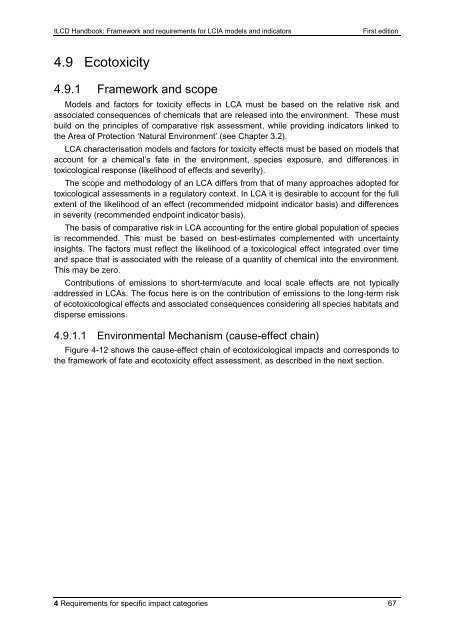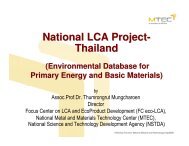ILCD Handbook: Framework and requirements for LCIA models and ...
ILCD Handbook: Framework and requirements for LCIA models and ...
ILCD Handbook: Framework and requirements for LCIA models and ...
You also want an ePaper? Increase the reach of your titles
YUMPU automatically turns print PDFs into web optimized ePapers that Google loves.
<strong>ILCD</strong> <strong>H<strong>and</strong>book</strong>: <strong>Framework</strong> <strong>and</strong> <strong>requirements</strong> <strong>for</strong> <strong>LCIA</strong> <strong>models</strong> <strong>and</strong> indicators First edition<br />
4.9 Ecotoxicity<br />
4.9.1 <strong>Framework</strong> <strong>and</strong> scope<br />
Models <strong>and</strong> factors <strong>for</strong> toxicity effects in LCA must be based on the relative risk <strong>and</strong><br />
associated consequences of chemicals that are released into the environment. These must<br />
build on the principles of comparative risk assessment, while providing indicators linked to<br />
the Area of Protection ‗Natural Environment‘ (see Chapter 3.2).<br />
LCA characterisation <strong>models</strong> <strong>and</strong> factors <strong>for</strong> toxicity effects must be based on <strong>models</strong> that<br />
account <strong>for</strong> a chemical‘s fate in the environment, species exposure, <strong>and</strong> differences in<br />
toxicological response (likelihood of effects <strong>and</strong> severity).<br />
The scope <strong>and</strong> methodology of an LCA differs from that of many approaches adopted <strong>for</strong><br />
toxicological assessments in a regulatory context. In LCA it is desirable to account <strong>for</strong> the full<br />
extent of the likelihood of an effect (recommended midpoint indicator basis) <strong>and</strong> differences<br />
in severity (recommended endpoint indicator basis).<br />
The basis of comparative risk in LCA accounting <strong>for</strong> the entire global population of species<br />
is recommended. This must be based on best-estimates complemented with uncertainty<br />
insights. The factors must reflect the likelihood of a toxicological effect integrated over time<br />
<strong>and</strong> space that is associated with the release of a quantity of chemical into the environment.<br />
This may be zero.<br />
Contributions of emissions to short-term/acute <strong>and</strong> local scale effects are not typically<br />
addressed in LCAs. The focus here is on the contribution of emissions to the long-term risk<br />
of ecotoxicological effects <strong>and</strong> associated consequences considering all species habitats <strong>and</strong><br />
disperse emissions.<br />
4.9.1.1 Environmental Mechanism (cause-effect chain)<br />
Figure 4-12 shows the cause-effect chain of ecotoxicological impacts <strong>and</strong> corresponds to<br />
the framework of fate <strong>and</strong> ecotoxicity effect assessment, as described in the next section.<br />
4 Requirements <strong>for</strong> specific impact categories 67



